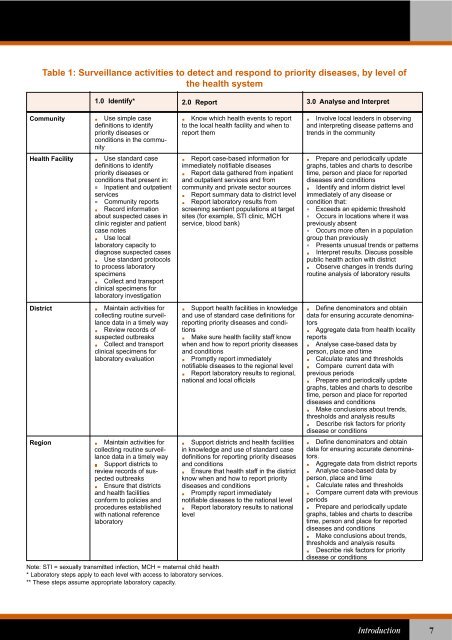Technical Guidelines for Integrated Disease Surveillance ... - PHRplus
Technical Guidelines for Integrated Disease Surveillance ... - PHRplus
Technical Guidelines for Integrated Disease Surveillance ... - PHRplus
You also want an ePaper? Increase the reach of your titles
YUMPU automatically turns print PDFs into web optimized ePapers that Google loves.
Table 1: <strong>Surveillance</strong> activities to detect and respond to priority diseases, by level ofthe health system1.0 Identify* 2.0 Report 3.0 Analyse and InterpretCommunityHealth FacilityDistrictRegionUse simple casedefinitions to identifypriority diseases orconditions in the communityUse standard casedefinitions to identifypriority diseases orconditions that present in:Inpatient and outpatientservicesCommunity reportsRecord in<strong>for</strong>mationabout suspected cases inclinic register and patientcase notesUse locallaboratory capacity todiagnose suspected casesUse standard protocolsto process laboratoryspecimensCollect and transportclinical specimens <strong>for</strong>laboratory investigationMaintain activities <strong>for</strong>collecting routine surveillancedata in a timely wayReview records ofsuspected outbreaksCollect and transportclinical specimens <strong>for</strong>laboratory evaluationMaintain activities <strong>for</strong>collecting routine surveillancedata in a timely way Support districts toreview records of suspectedoutbreaksEnsure that districtsand health facilitiescon<strong>for</strong>m to policies andprocedures establishedwith national referencelaboratoryNote: STI = sexually transmitted infection, MCH = maternal child health* Laboratory steps apply to each level with access to laboratory services.** These steps assume appropriate laboratory capacity.Know which health events to reportto the local health facility and when toreport themReport case-based in<strong>for</strong>mation <strong>for</strong>immediately notifiable diseasesReport data gathered from inpatientand outpatient services and fromcommunity and private sector sourcesReport summary data to district levelReport laboratory results fromscreening sentient populations at targetsites (<strong>for</strong> example, STI clinic, MCHservice, blood bank)Support health facilities in knowledgeand use of standard case definitions <strong>for</strong>reporting priority diseases and conditionsMake sure health facility staff knowwhen and how to report priority diseasesand conditionsPromptly report immediatelynotifiable diseases to the regional levelReport laboratory results to regional,national and local officialsSupport districts and health facilitiesin knowledge and use of standard casedefinitions <strong>for</strong> reporting priority diseasesand conditionsEnsure that health staff in the districtknow when and how to report prioritydiseases and conditionsPromptly report immediatelynotifiable diseases to the national levelReport laboratory results to nationallevelInvolve local leaders in observingand interpreting disease patterns andtrends in the communityPrepare and periodically updategraphs, tables and charts to describetime, person and place <strong>for</strong> reporteddiseases and conditionsIdentify and in<strong>for</strong>m district levelimmediately of any disease orcondition that:Exceeds an epidemic thresholdOccurs in locations where it waspreviously absentOccurs more often in a populationgroup than previouslyPresents unusual trends or patternsInterpret results. Discuss possiblepublic health action with districtObserve changes in trends duringroutine analysis of laboratory resultsDefine denominators and obtaindata <strong>for</strong> ensuring accurate denominatorsAggregate data from health localityreportsAnalyse case-based data byperson, place and timeCalculate rates and thresholdsCompare current data withprevious periodsPrepare and periodically updategraphs, tables and charts to describetime, person and place <strong>for</strong> reporteddiseases and conditionsMake conclusions about trends,thresholds and analysis resultsDescribe risk factors <strong>for</strong> prioritydisease or conditionsDefine denominators and obtaindata <strong>for</strong> ensuring accurate denominators.Aggregate data from district reportsAnalyse case-based data byperson, place and timeCalculate rates and thresholdsCompare current data with previousperiodsPrepare and periodically updategraphs, tables and charts to describetime, person and place <strong>for</strong> reporteddiseases and conditionsMake conclusions about trends,thresholds and analysis resultsDescribe risk factors <strong>for</strong> prioritydisease or conditionsIntroduction 7















